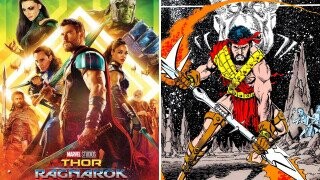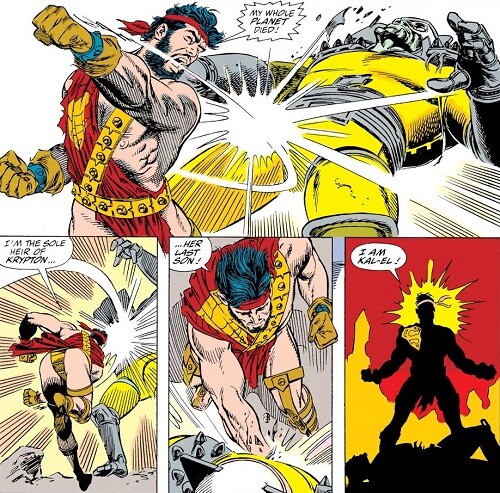Why 'Thor: Ragnarok' Is Secretly A Superman Movie

There's a cliche among superhero fans that The Iron Giant, the heartwarming animated tale of a boy and his giant killbot, is the best Superman movie without Superman in it -- or, according to some, the best Superman movie, period. And sure, it's a very nice movie and all, but it can't be the best Superman movie without Superman ... because that's Thor: Ragnarok. No, really. Hear us out.
For starters, the plot is so similar to a classic Superman storyline that we're gonna go ahead and classify it as an accidental adaptation. To recap, because there's been like 80 Marvel movies since this one came out in 2017, the central part of Thor: Ragnarok involves the titular hero having his powers greatly diminished (due to Cate Blanchett breaking his hammer), ending up stuck in a distant planet, being forced to compete as a gladiator in a giant arena with thousands of aliens watching, fighting a big green brute who seems to strongly dislike him, inspiring a revolt, and eventually collaborating with that brute to bring down the tyrant ruling that planet. Along the way, he discovers a dark family secret going back thousands of years and, speaking of family, there's also a storyline about his foster sibling, a shapeshifter of unclear allegiance and variable gender (Loki).
Don't Miss
Well, all of that also applies to the central part of Superman's "Exile in Space" storyline from 1989. The starting point is different: in this case, Superman ends up in space by his own will, after going through a bit of a mental breakdown due to the guilt of killing General Zod (via kryptonite instead of neck snap) and deciding he shouldn't be around people anymore. What's important is that he's also been humbled and goes on what Thor called "a journey of self-discovery." After wandering around space for a while and going through a very brief "space farmer" phase, Superman starts losing his powers from being so far away from the sun and is captured by a bunch of weird-looking aliens ...

DC Comics
... much like the weakened Thor when he lands on planet Sakaar.
Also like Thor, Superman is shackled and taken to the despotic ruler of this planet, who compliments him on his fighting spirit ("This one has the fire of a champion!" vs. "Well, he's a fighter!"). Both heroes are then given an involuntary makeover and forced to wear a space gladiator costume, except Superman's leaves a lot less to the imagination.

DC Comics, Marvel Studios
Next, Superman is told to fight the tyrant's champion, a big green guy called Draaga, while being watched by a huge crowd of aliens in a giant arena, but he refuses and offers him a friendly hand ... which Draaga just uses to sucker punch him. Pretty soon, Superman gets tired of being a punching bag and beats the crap out of his opponent.

DC Comics

DC Comics
So it's basically the Hulk fight from Ragnarok but without the jokes. (Yes, the basic "Hulk as a space gladiator" idea and look are taken from Marvel's Planet Hulk storyline, but that's about it.)
Both Superman and Thor inspire a revolution against the planet's tyrant, and they even manage to convince the green brute to help bring him down (though Draaga still hates Superman and would demand a rematch in a future story). And then there's the "family secret" part: Thor finds out his dad used to like invading neighboring realms with his secret daughter, and Superman learns that his ancestors created a xenophobic weapon called the Eradicator that was meant to get rid of aliens in Krypton but ended up preventing the Kryptonians from leaving their planet before it exploded. Hey, speaking of exploding planets:
As for the shapeshifter? While all of this is going on, there's a storyline back on Earth about Superman's adoptive parents taking care of "Supergirl," who in this version is actually a child-like artificial being from another dimension who can adopt different shapes. At one point she starts posing as Clark Kent in Metropolis and actually believes she's Clark, leading to a fight with Superman after he comes back. This ... is nothing like Loki's storyline, but we're throwing it in anyway.
In a broader sense, Thor: Ragnarok represents the kind of cosmic insanity that can be found in many classic Superman comics, but which DC has sadly never dared put to film. This movie owes a lot to the work of writer/artist Jack Kirby, from some thematic beats to the funky designs on the walls.
And though Kirby began developing his "cosmic" style while working at Marvel with Stan Lee, he only went nuts with it after jumping to DC -- and to the Superman family of comics in particular. A lot of fans forget that Kirby's creation Darkseid, the final boss of the DC Universe, first appeared in an issue of Superman's Pal, Jimmy Olsen. The first issue of Kirby's classic Forever People series co-starred Superman and features one of the character's most heartbreaking series of panels: Superman glimpsing a city of super-beings like him at the other end of a "Boom Tube" portal (which look a lot like the MCU's depiction of Thor's "rainbow bridge"), and rushes in thinking he's finally found a place where he'll fully belong, but stops himself at the last second because he can't abandon his commitment to humanity.

DC Comics
And that showcases what prevents Thor: Ragnarok from going from "best Superman movie without Superman" to "best Superman movie" -- for all the similarities in plot and style, Thor himself is pretty far from Superman's humble and noble-to-a-fault personality (at least in this movie). We can't imagine Superman lying to Bruce Banner about "winning easily" against Hulk or bragging about how good he used to be at throwing hammers. Superman is the sort of guy who, if he accidentally hit himself on the head with a bouncing ball, would take the L with dignity instead of trying to play it cool.
So far, the only adaptation of this storyline has been a pretty good two-part story in the Justice League cartoon ("War World" from season one) but nothing on the movie side. In other words, Ragnarok is yet another example of Marvel putting DC's best ideas on film before DC can. Please join us next time as we explain why the Apple store scene from Captain America: The Winter Soldier is the second-best cinematic depiction of Clark Kent ever.
Follow Maxwell Yezpitelok's heroic effort to read and comment on every '90s Superman comic at Superman86to99.tumblr.com.
Top image: Marvel Studios, DC Comics